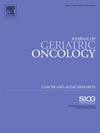Neutrophil-to-lymphocyte ratio, a predictor for mortality and unplanned hospital readmissions in patients aged 75 years and older with cancer.
IF 3
3区 医学
Q3 GERIATRICS & GERONTOLOGY
引用次数: 0
Abstract
Introduction
Assessing the prognosis of older patients with cancer is essential to determine the best strategy for oncological care, given the heterogeneous profiles of this population. Evaluation should consider frailty, comorbidities, geriatric parameters, and oncological parameters. Finding early prognostic indicators would be helpful to optimize care. We aimed to investigate the prognostic value of the neutrophil-to-lymphocyte ratio (NLR) in patients aged 75 and above with solid cancers.
Materials and Methods
Retrospective review of the ANCRAGE (ANalyse CanceR et sujet AGE) cohort that included all patients ≥75 years of age with solid cancer who were consecutively assessed in the geriatric oncology clinic of the University Hospital of Poitiers (France) between January 1, 2016 and August 31, 2023. Pretreatment assessment included socio-demographic data, oncological, clinical frailty scale (CFS) and geriatric assessment (GA). Geriatric domains assessed were level of dependence, risk of falls, nutrition, mood, and cognition. We defined frailty as the presence of at least one impairment in any of the geriatric domains. The NLR was determined within seven days before or after the GA and before any specific cancer treatment. Survival curves and Cox regression analyses were performed to assess the prognostic values in terms of overall survival (OS) and unplanned hospital readmissions (UHR).
Results
Overall, 1446 patients were included. Mean age was 86.6 years (± 5.2 years), with a male predominance (59 %). Most prevalent cancer sites were prostate (20 %, n = 283), colorectal (16 %, n = 230), breast (15 %, n = 217), skin (9 %, n = 134), and lung (7 %, n = 103), with metastatic status in over one-third of cases. The pretreatment GA identified frailty in 70 % of cases (n = 1012), with malnutrition (54 %, n = 774) and risk of falls (37 %, n = 538) being the main contributing factors. Median NLR was 3.50 [2.34–5.31]. There was a significant association between NLR and frailty using the CFS score (p < 0.001). The median follow-up time for OS analysis was 487 days [186–957]. The results of the multivariate analysis indicated that pretreatment NLR was an independent predictor of OS (hazard ratio [HR] 1.010, 95 % CI: 1.005–1.015, p < 0.001) and of UHR (HR 1.057, 95 % CI: 1.014–1.101, p = 0.008). Cut-off value >3.5 was associated with lower OS (p < 0.001).
Discussion
In our study, NLR was independently associated with higher mortality and high risk of unplanned hospital readmissions within one year of GA in older patients with solid tumors.
中性粒细胞与淋巴细胞比率:75岁及以上癌症患者死亡率和意外再入院的预测因子
鉴于这一人群的异质性,评估老年癌症患者的预后对于确定最佳肿瘤治疗策略至关重要。评估应考虑虚弱、合并症、老年参数和肿瘤参数。发现早期预后指标将有助于优化护理。我们的目的是研究中性粒细胞与淋巴细胞比值(NLR)在75岁及以上实体癌患者中的预后价值。材料与方法对2016年1月1日至2023年8月31日期间在法国普瓦捷大学医院老年肿瘤学门诊连续评估的所有≥75岁实体癌患者的ANCRAGE (analysis CanceR et sujet AGE)队列进行回顾性分析。预处理评估包括社会人口学数据、肿瘤、临床衰弱量表(CFS)和老年评估(GA)。评估的老年领域包括依赖程度、跌倒风险、营养、情绪和认知。我们将衰弱定义为在任何老年领域中至少存在一种损伤。NLR是在GA前后和任何特定癌症治疗前7天内确定的。通过生存曲线和Cox回归分析来评估总生存期(OS)和非计划住院再入院(UHR)的预后价值。结果共纳入1446例患者。平均年龄86.6岁(±5.2岁),以男性为主(59%)。最常见的癌症部位是前列腺癌(20%,n = 283)、结直肠癌(16%,n = 230)、乳腺癌(15%,n = 217)、皮肤癌(9%,n = 134)和肺癌(7%,n = 103),超过三分之一的病例具有转移状态。预处理GA在70%的病例(n = 1012)中发现虚弱,其中营养不良(54%,n = 774)和跌倒风险(37%,n = 538)是主要影响因素。中位NLR为3.50[2.34-5.31]。使用CFS评分,NLR和虚弱之间存在显著关联(p <;0.001)。OS分析的中位随访时间为487天[186-957]。多因素分析结果显示,预处理NLR是OS的独立预测因子(风险比[HR] 1.010, 95% CI: 1.005-1.015, p <;0.001)和UHR (HR 1.057, 95% CI: 1.014-1.101, p = 0.008)。截断值>;3.5与较低的OS相关(p <;0.001)。在我们的研究中,NLR与老年实体瘤患者GA一年内较高的死亡率和意外再入院的高风险独立相关。
本文章由计算机程序翻译,如有差异,请以英文原文为准。
求助全文
约1分钟内获得全文
求助全文
来源期刊

Journal of geriatric oncology
ONCOLOGY-GERIATRICS & GERONTOLOGY
CiteScore
5.30
自引率
10.00%
发文量
379
审稿时长
80 days
期刊介绍:
The Journal of Geriatric Oncology is an international, multidisciplinary journal which is focused on advancing research in the treatment and survivorship issues of older adults with cancer, as well as literature relevant to education and policy development in geriatric oncology.
The journal welcomes the submission of manuscripts in the following categories:
• Original research articles
• Review articles
• Clinical trials
• Education and training articles
• Short communications
• Perspectives
• Meeting reports
• Letters to the Editor.
 求助内容:
求助内容: 应助结果提醒方式:
应助结果提醒方式:


